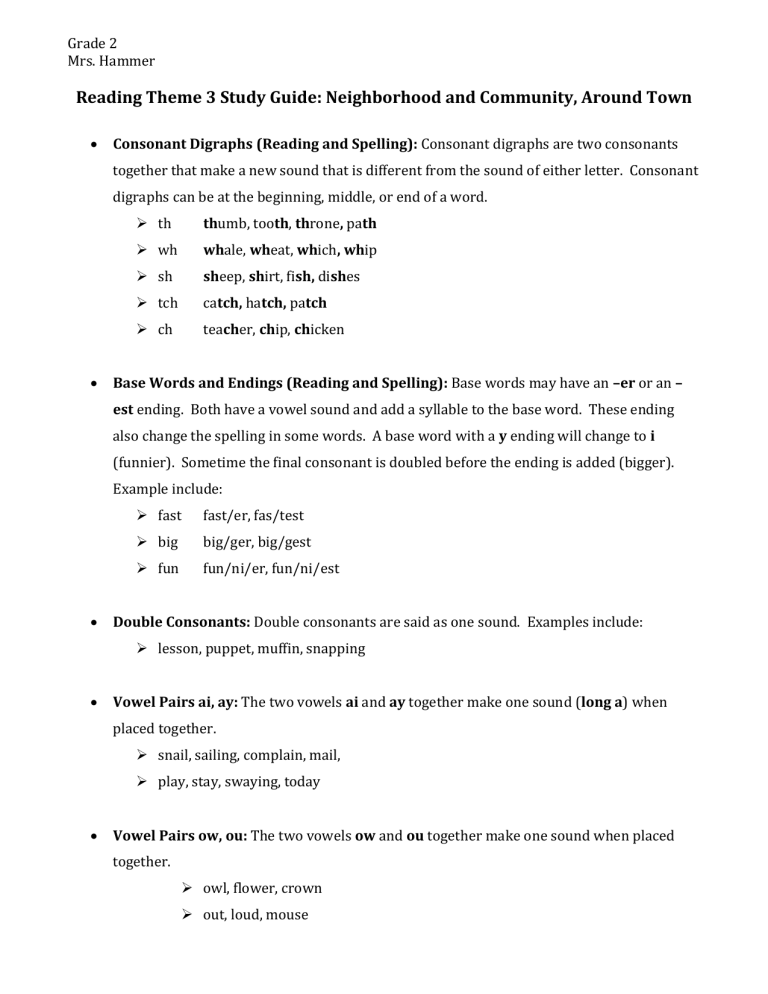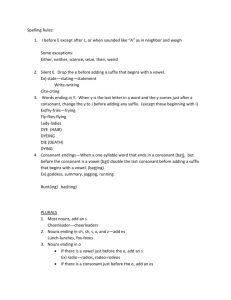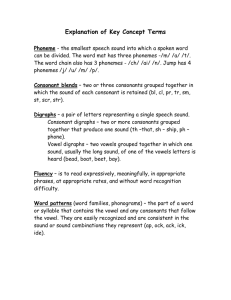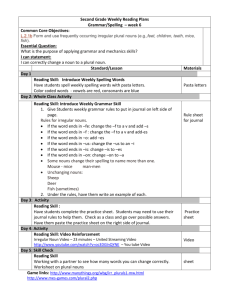Grade 2 - SchoolWorld an Edline Solution

Grade 2
Mrs. Hammer
Reading Theme 3 Study Guide: Neighborhood and Community, Around Town
Consonant Digraphs (Reading and Spelling): Consonant digraphs are two consonants together that make a new sound that is different from the sound of either letter. Consonant digraphs can be at the beginning, middle, or end of a word.
th thumb, tooth, throne, path
wh whale, wheat, which, whip
sh sheep, shirt, fish, dishes
tch catch, hatch, patch
ch teacher, chip, chicken
Base Words and Endings (Reading and Spelling): Base words may have an –er or an –
est ending. Both have a vowel sound and add a syllable to the base word. These ending also change the spelling in some words. A base word with a y ending will change to i
(funnier). Sometime the final consonant is doubled before the ending is added (bigger).
Example include:
fast fast/er, fas/test
big big/ger, big/gest
fun fun/ni/er, fun/ni/est
Double Consonants: Double consonants are said as one sound. Examples include:
lesson, puppet, muffin, snapping
Vowel Pairs ai, ay: The two vowels ai and ay together make one sound (long a) when placed together.
snail, sailing, complain, mail,
play, stay, swaying, today
Vowel Pairs ow, ou: The two vowels ow and ou together make one sound when placed together.
owl, flower, crown
out, loud, mouse
Vowel Pairs ee, ea: The two vowels ee and ea together make one sound (long e) when placed together.
feet, sleep, Halloween
neat, reason, eagle
Suffixes –ly, -ful: Some words are made up of base words and a special ending called a suffix. The suffix –ly means “in a ____ way” and the suffix –ful means “full of ____”.
Common Syllables –tion, -ture: You should be able to read words with endings -tion and
–ture. Both endings add a syllable to the word.
Vocabulary
Compound Words: Unfamiliar words might actually be compound words made of two shorter words that you already know (rain/drop, mail/box, day/time).
Using a Dictionary: ABC Order to the Third Letter: You should be able to place words in alphabetical order by looking at the third letter in each word:
wake, walk, watch
head, help, herd
Dictionary: Beginning, Middle, End: It is helpful to think about the beginning, middle, and end when using a dictionary. For example, if a word begins with a b, students should look in the beginning of the dictionary because b is at the beginning of the alphabet.
Beginning: A-K
Middle: L-S
End: T-Z
Using Context: You can use context clues (other words in the sentence) to help you find out the meaning of unknown words.
Dictionary: Guiding Words: The words at the top of the page in dictionaries are called guiding words. You can use guiding words to help you find the word you are looking for.
Vocabulary: You should be able to read and know the meanings of the following words:
Chinatown: apartment, delivery, handcarts, restaurant, market, celebrations
Trip to the Fire House: chief, dispatch, emergencies, fire engine, firefighters, gear
Big Busty Mustache: bushy, disguise, handsome, mirror, mustache
Jamaica Louise James: booth, plaque, station, subway, token
High Frequency Words: You should be able to read and know the meanings of the following words:
Chinatown: winter, heard, lion, during
Trip to the Fire House: clothes, guess, order
Big Bushy Mustache: behind, soldier, story
Jamaica Louise James: believe, lady, whole
Grammar
Naming Words/Nouns: A noun is a word that names a person, place or a thing.
Special Nouns/Proper Nouns: A special noun is a word that names a certain person, place or thing. Special nouns always begin with capital letters.
Exact Nouns: An exact noun gives the reader more detail about the person, place, or thing that is being discussed. For example: My dad bought me a new toy to ride. My
dad bought me a new bike to ride. Bike is a more exact noun for toy.
One, More than One: Most nouns add s to name more than one (one girl, two girls).
Nouns that end in c, x, ch, and sh add es to name more than one (one watch, two watches).
Nouns that Change Spelling in the Plural: Some nouns have a different spelling when they name more than one (one child, three children; one man, two men)
Reading Strategies: You should know what each of these strategies and how to use them when reading.
Summarize: When you summarize, you tell the main parts of the story in your own words.
Question: When you question you ask a fellow reader a question that you know the answer to after reading.
Predict/Infer: When you predict you use information from the text to tell what is likely to happen.
Evaluate: When you evaluate you decide what you like and do not like about the story and the illustrations.
Phonics/Decoding: When you come to a word you don’t know 1) Look carefully at the word, 2) Look for word parts you know and think about the sounds for the
letter, 3) Blend the sounds to read the word, 4) Ask yourself: Is it a word I know?
Does it make sense in what I am reading? 5) If not, ask yourself: What else can I try?
Comprehension/Reading Skills: You should know these reading skills and how to use them when reading.
Making Judgments: When you make a judgment about a story, you decide if you like and what you don’t like about it. There is no right or wrong answer when you make a judgment about a story, but it is important to be able to support your opinion with information from the story and your own experiences.
Topic, Main Idea, Detail: The topic of the story is what the story is about as a whole.
A main idea is what the page in a book or a paragraph is mostly about. Details are the smaller bits of information about the main idea.
Problem Solving: A story problem is a bad situation that a character wants to change. The problem is what makes the story interesting. Sometimes what a character does may not solve the problem right away, but it may lead to a solution later. When readers are able to see how events lead to a solution, they understand what the character has learned.
Making Inferences: When you read a story you can use clues from the story and what you already know to make guesses about what you hear.
Reading a Schedule
You should be able to find the name of the schedule and understand which events take place on certain days and times.








